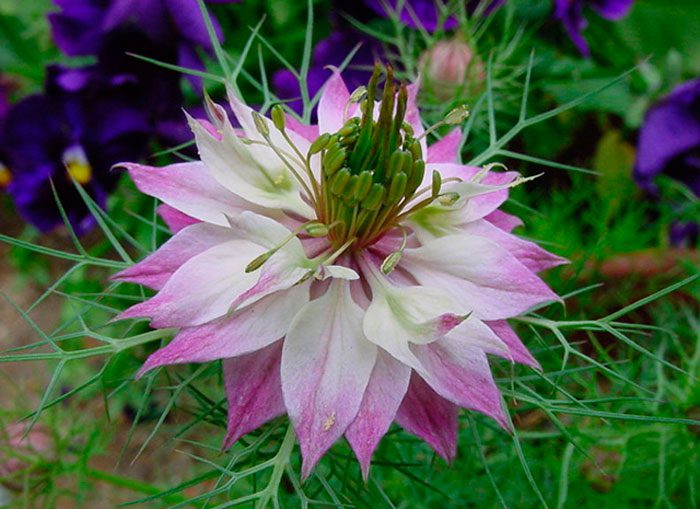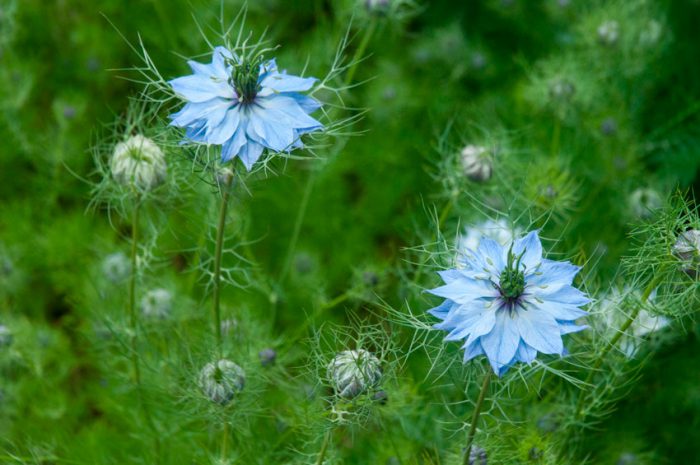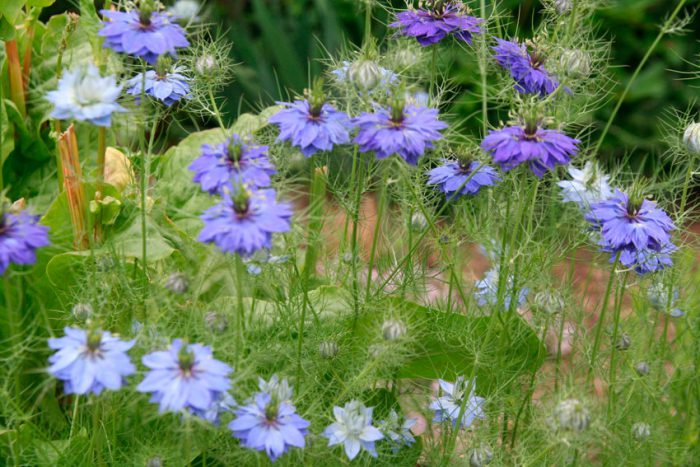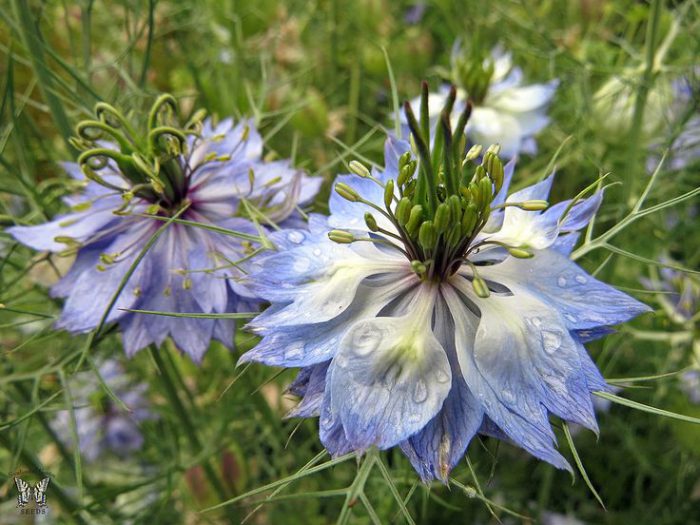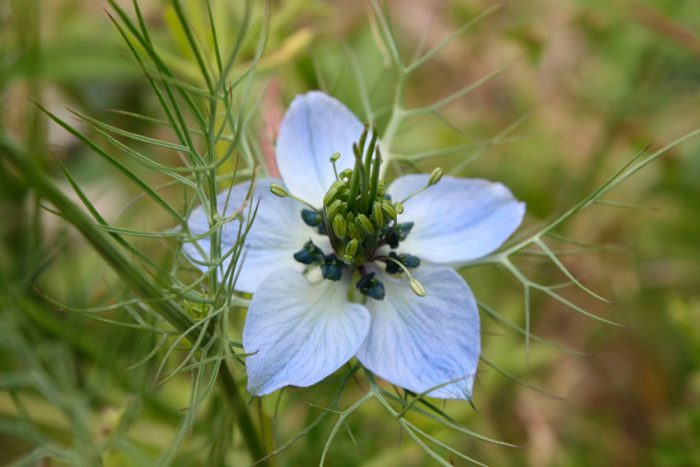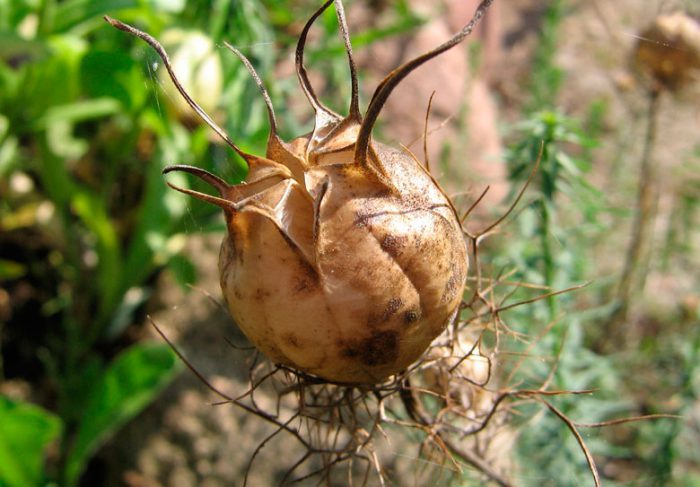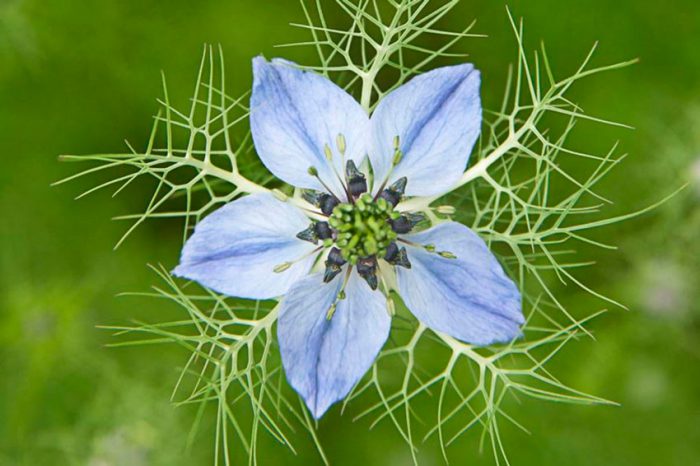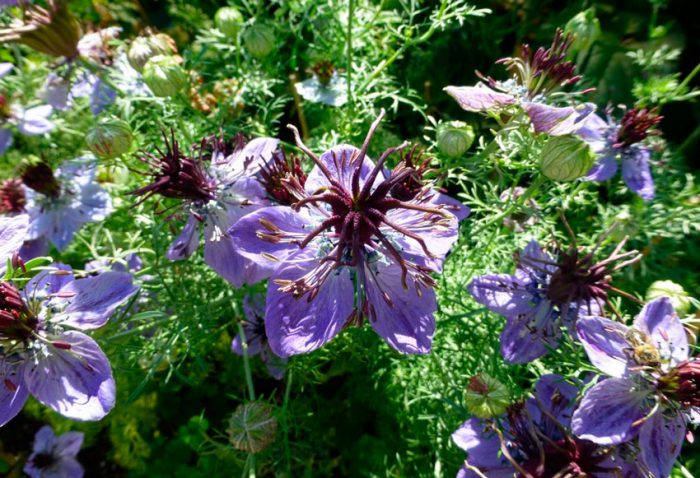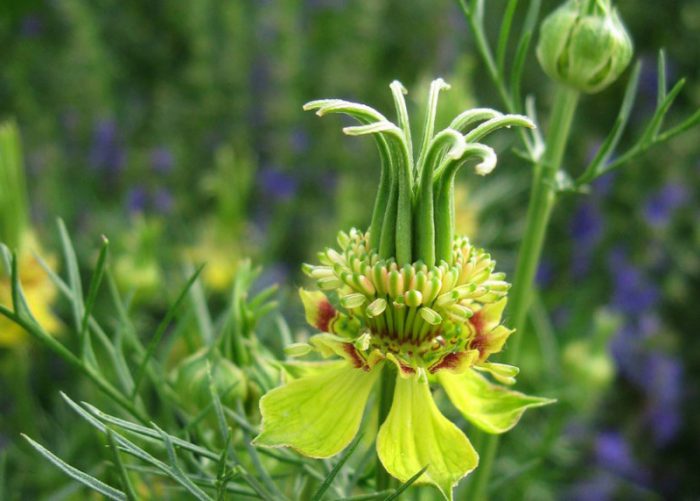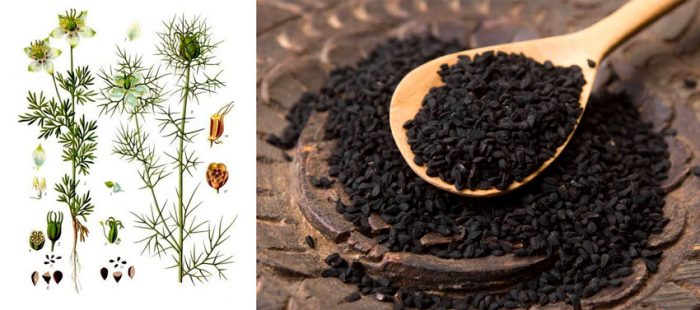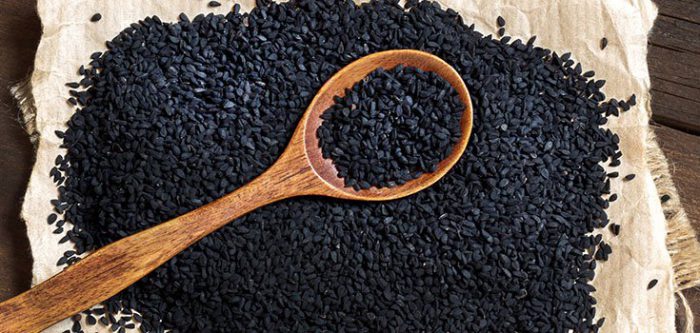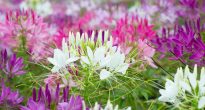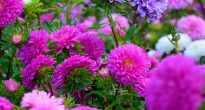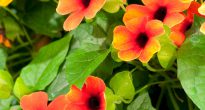The herb Nigella (Nigella), also called nigella, is directly related to the buttercup family. This genus unites more than 20 species of various plants. In natural conditions, they can be found in Western Asia, Western Europe and North Africa. The Latin name comes from the word "niger", which translates as "black". And the plant got this name due to the fact that its seeds are painted in a coal-black color. At first, Nigella ended up in the North Caucasus and in Turkey, and from there she found herself in India, and from there to European countries. In England, this plant is called blessed seeds, black caraway, nutmeg, kalindzhi, flowering fennel, black sesame, and Italian coriander, but Nigella has nothing to do with any of the mentioned plants.
Content
Features of nigella
Nigella is an annual herb with branched shoots and reaching a height of 0.3–0.6 m. Alternate lacy leaf plates can be finger or pinnately dissected. The upper leaves rise above the plant, resembling an openwork veil. The diameter of single bisexual flowers is about 4 centimeters, they have 5 sepals that look like petals. The flower color can be white, blue or yellow. If the flowers are double, then their sepals are placed in 2, 3 or 4 rows. The flower petals are transformed into nectaries. The fruit is a bloated or flattened box, which consists of 5 leaflets. Inside the fruit are ovoid matte black seeds.
Nigella is considered an essential element of landscape design. Such plants are planted along curbs and hedges, they are used to decorate rockeries, flower beds and alpine hills, and nigella is also used as an element of floral arrangements.
Growing nigella from seed
Sowing
This plant can only be propagated by seeds. It is recommended to sow them in open soil in May or before winter, while deepening them into the soil by 20 mm. The seedlings that appear are quite cold-resistant, but still, at first, experienced gardeners recommend covering them. Seedlings react extremely negatively to transplanting, in this regard, the sowing of seeds must be done immediately to a permanent place.
Seedling
Sowing for seedlings is carried out in March or April in a greenhouse, while the seeds are buried into the substrate by only 20 mm. The first seedlings should appear 14–20 days after sowing. When the first pair of true leaves begins to develop, the seedlings will need to dive into individual peat-humus pots. It will be necessary to plant the grown seedlings directly in these pots.
Planting nigella in open ground
What time to plant
Nigella seedlings are growing relatively quickly, and in May it can be planted in the garden at a permanent place. A site for such a plant should be chosen well-lit and open, the fact is that in a shaded place it grows and develops much worse. Also, when choosing a place for planting nigella, it should be borne in mind that the neighborhood with ground cover plants is not suitable for her. Suitable soil should be dry, loose, light, rich in nutrients, neutral or calcareous. Sour soil is not suitable for planting.
How to drop off
Seedlings should be planted directly in peat-humus pots, while a distance of 15 to 20 centimeters between the bushes must be maintained, and the row spacing should be from 45 to 50 centimeters. If you plant the nigella too thickly, then this will negatively affect flowering, and the seeds will not have time to ripen. When the seedlings are planted in open soil, they must be well watered. You should not cover the surface of the site with a layer of mulch, since Nigella reacts negatively to mulching. Flowering begins approximately 40–45 days after the seedlings appear and lasts approximately 8 weeks.
Caring for nigella in the garden
Taking care of the nigella, it is necessary to systematically loosen the surface of the site, while removing weeds, since this plant reacts negatively to mulch. As for moistening the soil, it should be remembered that frequent and rare watering can harm such a flower. In this regard, it is recommended for Nigella to develop a special watering regime. When feeding this flower, one must remember that it is quite easy to overfeed it, so you should also be very careful here. In this regard, experienced gardeners advise planting nigella in the area where the predecessors fed with organic fertilizers were grown. In this case, until the middle of the period of active growth, such flowers do not need to be fed at all. During flowering, you should feed the plant with phosphorus-potassium fertilizer.
Breeding nigella
Such a plant can only be propagated by seeds, either seedling or seedling. Sowing seeds in open ground can be done in spring or before winter. How to grow nigella from seeds is described in detail above. Self-seeding is also considered a breeding method for nigella.
Diseases and pests
If the weather is damp and cool for a relatively long time, then the risk of nigella becoming infected with powdery mildew increases. In order to save the plants, it is recommended to carry out 2 or 3 treatments of the bushes with a fungicide with intervals between sessions of 7-10 days. If in the summer there is a prolonged dry period, and the nigella are not watered in a timely manner, then spider mites can settle on them, which suck the vegetable juice from the leaves. In order to get rid of spider mites, it is necessary to treat plants with insectoacaricides, for example: Aktellik, Kleschevit, Agravertin, Akarin or Fitoverm. However, you should not be scared, since with proper care and cultivation, Nigella is distinguished by a fairly high resistance to both diseases and harmful insects. And the seeds of such a flower have a very pleasant smell that can scare off pests.
Nigella after flowering
The signal to start collecting nigella seeds is the ripening of about 2/3 of the capsules, this time, as a rule, falls on the last days of August or September.Mature boxes are cut along with the shoots, and then tied into bunches, which are laid out in a dry, ventilated room to dry. When the boxes are dry, shake out the seeds from them, which remain viable for 2 years. These seeds can be sown immediately after harvesting before winter, or do it in the spring.
Types and varieties of nigella with photos and names
Nigella damasceana
Among gardeners of middle latitudes, this species, also called "the lady in the green", is the most popular. The fact is that such a plant has beautiful not only flowers, but also leaf plates. In natural conditions, such flowers can be found in Asia Minor and Asia Minor, in the Crimea, the Caucasus and the Mediterranean. Branched shoots can be up to 0.3–0.5 meters in height. The leaf plates are three times or twice pinnately dissected. The color of double or simple flowers can be blue, white or blue. The flowers seem to be surrounded by a spectacular "blanket" consisting of openwork leaves, located on the shoots directly under the flowers. There are a large number of varieties of this type of nigella, but it should be remembered that not all of them are highly decorative. For example, the Baby Blue variety is more like a green lump, reaching a height of 15 centimeters and having tiny flowers and ugly horned fruits. The most decorative varieties include:
- Cambridge Blue... Delicate stems can reach 0.9 m in height, the color of semi-double flowers is blue.
- Miss Jekyll Rose... Very straight stems reach half a meter in height. The color of the flowers is dark pink-red. This variety was created specifically for florists who use it to compose dry or fresh flower arrangements.
- Persian Jewels... This variety includes plants with blue, lilac-pink, white or pink flowers.
- Dwarf Moody Blue... The height of such a dwarf plant can reach 15–20 centimeters. The color of the flowers is blue.
Sowing nigella (Nigella sativa)
This species is cultivated as a medicinal plant. The height of such an annual plant can vary from 0.3 to 0.7 meters. White, blue or yellow-green flowers can be double or simple, they look very impressive against the background of finely dissected lacy leaf plates, outwardly similar to fennel foliage. The black seeds of this type of nigella have a very strong spicy smell, which is why they have been used as a seasoning for various dishes for many hundreds of years. Choleretic and gastric remedies are also prepared from such seeds. This species includes names such as black cumin, black sesame and flowering fennel. And in the Quran it is written about him: "In the black cumin heals from all diseases."
Spanish Nigella (Nigella hispanica)
This species is not so well known. The birthplace of such an annual is northern Africa and southern Spain. The bush can reach a height of 0.6 meters. Deeply divided leaf plates are colored dark green. The diameter of the dark blue flowers is about 6 centimeters, they have a mild odor and brightly colored stamens. Light red ovaries of this type are also quite spectacular. Flowering occurs in June – September.
Nigella orientalis
This type is not very popular. They decorate flower beds, and also such flowers are grown for cutting and for drawing up dry bouquets. This annual plant has small flowers and spectacular seedlings.
Nigella properties
Nigella sowing (Nigella medicinal) is used not only to decorate the garden. The seeds of this type of nigella have a strawberry smell and a pungent peppery taste, therefore they are widely used in cooking as a spice. For example, such seeds are added during baking in buns and bread, in marinades during the manufacture of canned vegetables, and they are also used in powder form during the preparation of soups.The leaves of this plant are eaten like herbs, the fact is that they have a tonic and tonic effect. In the summertime, these leaves are used to make a salad along with coriander, dill, basil, parsley and chervil.
Such a plant not only tastes good, but it is also very useful. So, in the seeds of Nigella medicinal there is carotene, essential oils, vitamin E, ascorbic acid, as well as the lipase enzyme. Due to this, they have a laxative, antispasmodic, antifungal, antioxidant, bronchodilatory, antiviral, anthelmintic, diuretic, analgesic, antiulcer, antibacterial, antiallergenic, antitumor, immunostimulating and choleretic effect. They are recommended for use in high blood pressure, dysbiosis, periodontal disease, pyelonephritis, flatulence and gastrointestinal disorders, hormonal disorders, vegetative vascular dystonia, cystitis and poor appetite. Such seeds can strengthen memory, improve the functioning of the liver and pancreas, and also contribute to the fact that the aging process in the body slows down. These seeds, together with certain medicines, treat diseases such as: diabetes mellitus, arterial hypertension, epilepsy, asthma, malignant tumor and drug addiction. Tea made from such seeds helps to accelerate metabolic processes in the body and cleanses it of toxins and toxins, and it also helps to lose weight.
Several fairly well-known folk remedies from Nigella sowing:
- Nigella Seed Tincture... The seeds must be combined with vodka in a 1: 5 ratio. The resulting mixture is removed to a dark place for 7 days. Then the tincture will only have to be filtered and put on the refrigerator shelf for storage. In case of diseases of the respiratory tract, they drink this tincture in 10-15 drops.
- Tea... 200 mg of freshly boiled water must be combined with 1 gram of nigella seeds. Let it brew for 15 minutes. Such tea should be drunk during the day in small portions, while it will have a laxative, tonic, diuretic and choleretic effect on the body. To achieve the anthelmintic effect, during the day you need to drink at least 2 liters of such a remedy, at the same time you need to eat spicy food (herring, onions, etc.). These seeds differ in that they have almost the same pungency as black pepper, but at the same time they do not irritate the digestive tract.
- Delicious Seed Tortillas... You will need 1 kg of flour, from which you need to prepare the dough in water. 1.5 large tablespoons of nigella seeds are poured into it and everything mixes well. The dough should stand from 40 to 50 minutes, then juices are formed from it, which are rolled into flat cakes. They are baked in the oven and then coated with oil while still hot.
Nigella seeds are also widely used in the fight against moths. The seeds are poured into small bags of gauze or cloth, which are tightly sewn up. The pouches are then placed on the shelves in the cabinet. Interestingly, the aroma of these seeds can scare away not only moths, but mosquitoes and snakes as well.
However, Nigella has a number of contraindications, funds from such a flower cannot be used:
- pregnant women (especially in the later stages);
- patients with active thrombophlebitis;
- with gallstone disease;
- with ischemic heart disease;
- with acute gastritis with high acidity.
Still, such funds must be completely excluded for people with transplanted organs. The fact is that they strengthen the immune system, and this can lead to the rejection of the implanted organ.

